We’re heading out to the Wildenburger Land, an obscure former feudal territory east of Siegen, past lush meadows and green forests to Hundscheidt, now a part of the municipality of Friesenhagen. At the end of a narrow road, we enter a large farmyard, marked with a half-overgrown sign saying Academy for Subsistence and Holistic Living. Did we take a wrong turn somewhere? A barn swings open and out steps Johannes Gehrke and his brother Christoph. As I would later find out, it’s Christoph who is realising his dream of a largely self-sufficient lifestyle here on the farm. So that explains the sign. Also on-hand, Johannes’ gallerist and patron Kai Brückner, who has arranged our visit.
Change of scene.
Amidst this rural idyll, the gates to an entirely new world are opened for us: bizarre sculptures, flashing lights, framed by large-scale paintings draw our attention. A futuristic projectile, the Statue of Liberty in a floral print skirt, a strange construct made of different kinds of street lights… Prototype for a new edition of Alice in Wonderland?
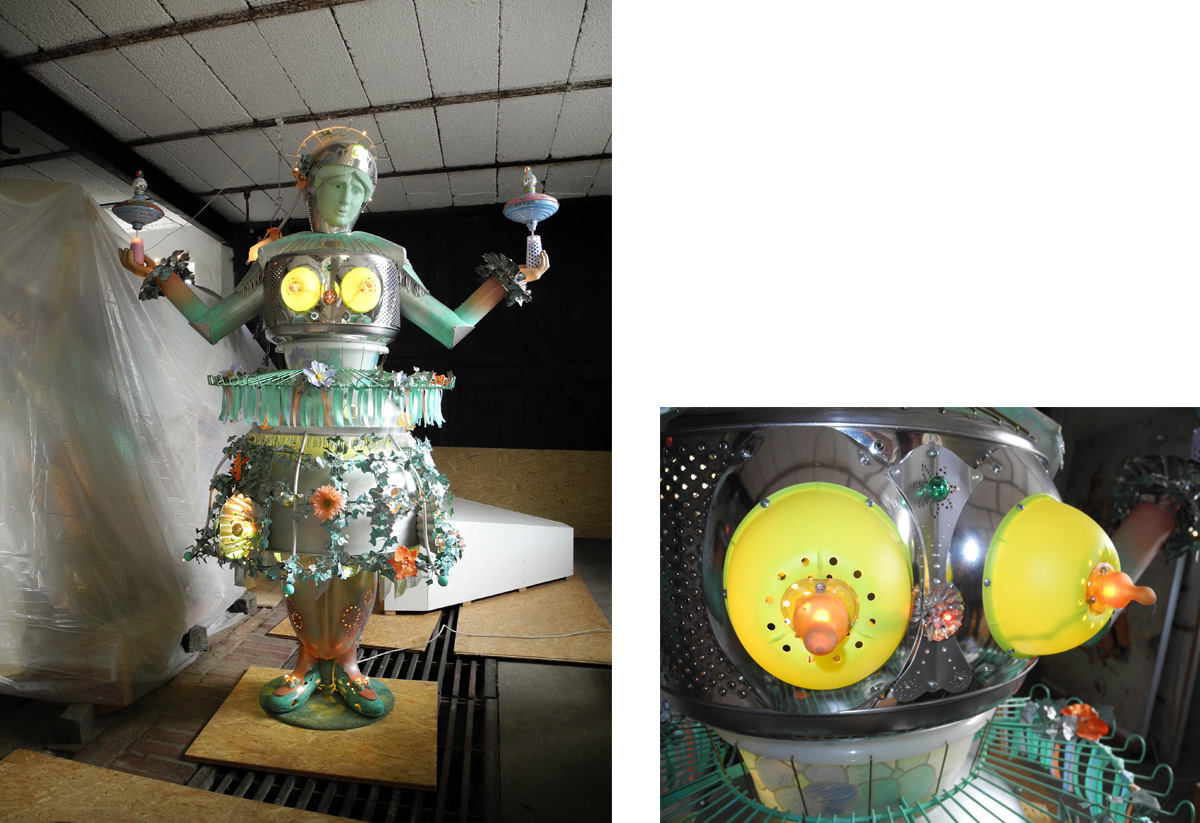
FIGURINE OF MISS LIBERTY (2004)
I step closer and start to disassemble the strange visions before me. Gradually, I discover everyday things in their midst: toasters, washing machine drums, bicycle lamps, car rims, antennas, toilet brushes, spinning tops, egg cups, etc. It was obvious that these objects’ former function was not so much of interest as their shapes. A washing machine drum can become a torso, common kitchen graters can become wings, and recorders can become turbines. And seductive little buttons everywhere. Should I press one? Gehrke follows my eyes as they wander and finally saves from the agony of my curiosity. And so the performance starts. It flashes, it rattles, it belches out steam. All run by meticulously elaborate analogue control technology, some of visible, and some of which is hidden away inside the sculpture. With a sense of glee, Gehrke demonstrates the interactivity of his sculptures and explains their roles within the complex history of <em>Operation Edelstein</em>. What were once robotic machines are liberated from their anonymity and appear to have come alive as we dive into the fantastic parallel universe of Johannes Gehrke.
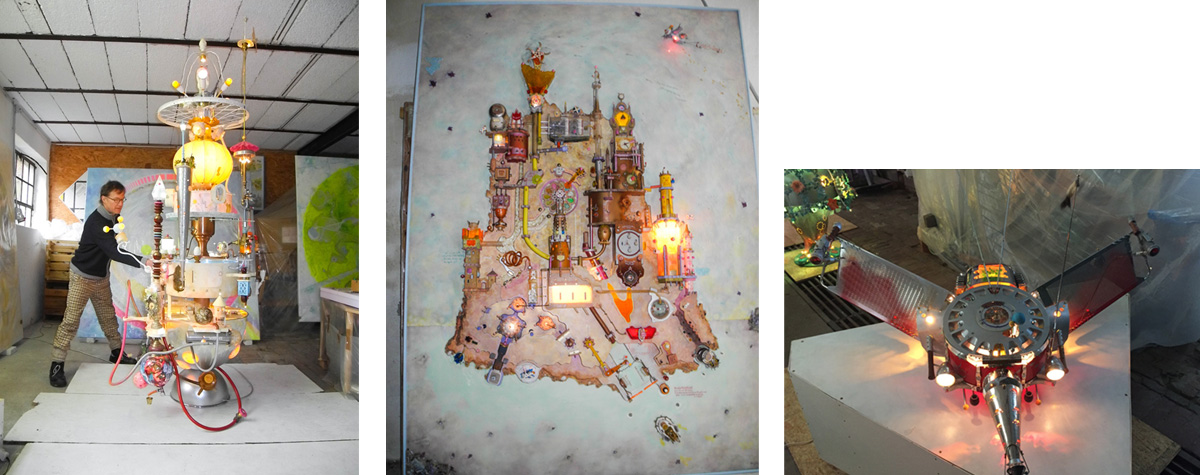
Image 1: RECORD MACHINE (2016) – Image 2: EXODUS – SUCHE EINER ZUFLUCHTSINSEL (1987) – Image 3: TIME-SPACE FLIGHT (2002)
The starting point of the history goes back to 1986 and a failed genetic experiment. A ladybird, seen as a sign of luck in Germany, was supposed to flood the world with every imaginable good, instead mutated into a monster, the P.I.M.S. that would make life for people on earth a living hell. Each episode in the series, which Gehrke continued to produce through 2014, reflected key themes of a globalisation that seemingly could not stop. With amazing foresight, Gehrke recognised the dangers of subsequent environmental policy decisions, the risks associated with progressing mechanisation, and the power of information and communication exchange that currently seems to have taken control of human society in a frightful manner. The individual episodes can be read in Gehrke’s History Binder, which is the first part of the entire series. So it with excitement that I open the large-format portfolio, my hands wrapped in white gloves, and look at the some of the Story Sheets. The portfolio seems like a script, a storyboard, and a comic, with careful lettering and drawings done with the finest eye for detail. I frequently catch sight of Gehrke himself amid the faces of well-known politicians. It’s particularly exciting to see the same fantastical creations I had just seen in 3-D here on the written page. Which came first, I ask, the text or the figure? “It’s quite clear that the text determines the figure,” answers Gehrke. But he had no idea how the figures would evolve in detail when he started on them. That’s all a part of the creative process.
That’s what I figured. And I expect that the studio spaces would belie this process: a wild mess of random things waiting to be used. My expectations now set, I continue to make my way. But I’m completely wrong. Like a well-stocked hardware store, the space is filled with shelves from floor to ceiling full of countless, carefully labelled boxes; the actual studio next-door seems more like an engineer’s work station than a classic artist’s studio. On the wall hangs the design plans for Gehrke’s current project RECORD MACHINE. It’s worthwhile taking a closer look at these drawings, because they allow the individual phases of the work process to be traced. An initial pyramidal skeleton can be seen, further developed on the next sheets in a collage-like process. Add-ons and even circuit diagrams are always drawn separately and then glued in place at the appropriate location. “This primarily serves to document the technical functions. Everything must remain traceable,” says Gehrke. It is astonishing that these are not just simple design sketches, but full-quality drawings that would later go into portfolio.

Studio impressions …
History Portfolio, paintings, sculptures, a script. And so what’s the goal with all this? Is this video art done on an analogue basis? – Nope. Possible answers await in the SHRINE, a converted chest with a dollhouse-like construction. “This is the central nervous system of the entire series, the holy-of-holies,” I’m told. I clearly recognise the sign as the exhibition hall of a museum in miniature, with an adjoining room labelled DOMBAUHÜTTE , the place where the trades once crafted cathedrals, the origins of art created on commission. It symbolises his studio, Gehrke tells me. But he is neither craftsman nor artist producing works on commission, I realise with some irritation, so I take a closer look at what’s on display in the miniature exhibition hall.
It is of course Operation Edelstein (see the photo of Gehrke when looking into the SHRINE). The two-dimensional story from the portfolio is being told here in three dimensions. The subtitle EIN MENSCH EIN RAUM on the item label here describes the holistic, architectural nature of the installation. Various projectiles hang from the ceiling, all in miniature size, P.I.M.S. and ladybirds set the stage for various scenes, framed by paintings along the top edge of the exhibition hall, allowing us to immerse ourselves into the seemingly fantastic, technology-dominated world of Operation Edelstein, which museum visitors are invited to explore. In the presentation of this playfully interactive discovery tour, confusing questions suddenly race through my mind: Who’s in control here? Who or what’s being controlled here? Does the choice of button we dare to press reveal something about ourselves? I think of how our communication in the digital world is being tracked. Is that perhaps analogous to that failed genetic experiment which is at the core of this work?
EIN MENSCH EIN RAUM, so says the subtitle. Space suddenly seems so tight. is Operation Edelstein Gehrke’s reflection of a rapidly changing world? Or perhaps of a manipulative centre of power to which he and the whole of humanity are subjugated? In which we are trapped without our being aware of it? Who or what is sitting at the controls of this power centre? Who’s controlling whom? I realise the room for interpretation allowed here might point to the complex ways with which this exhibition could be viewed and experienced.
I also realise that there is no name for this type of art. Not even a “That’s a little bit like…” “. It is something completely new. We leave the studio spaces, leave the alternate universe of Johannes Gehrke, and now enter the parallel universe of his brother Christoph. After the aggressive gander lets us know that he’s in charge of the farmyard, we make our way to the pond in the middle of a reclaimed wetlands. Not only are coffee and cake awaiting us on the table, but also the ingredients for our supper. While Kai Brückner, Johannes Gehrke, and I still discuss why this art has remained largely undiscovered, my husband Peter digs potatoes and picks broad beans and discusses subsistence farming with Christoph Gehrke.
I now know just how delicious ecologically grown vegetables taste. What it means to have become a part of the Operation Edelstein story, not so much. All I can say is this: Curators and museum directors of the world, make room for this interactive work of art!
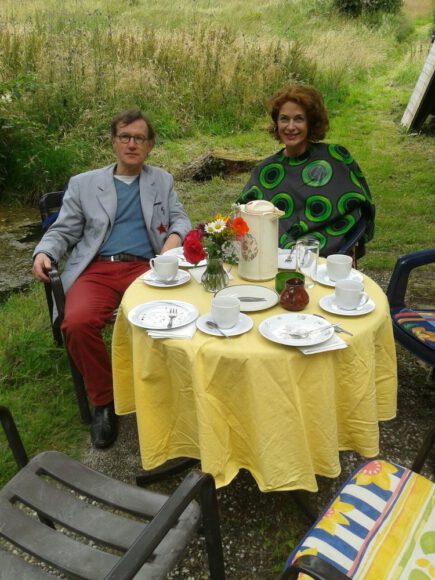
Johannes Gehrke and Elke Backes
More Information
CV: https://johannes-gehrke.info/vita
Available Works at einsvonelf: johannes-gehrke

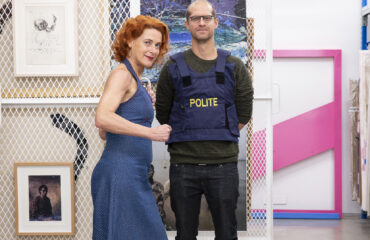

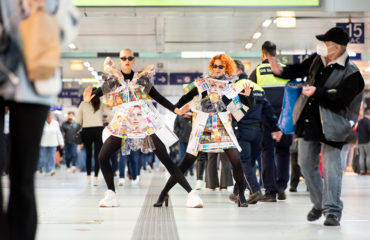
You must be logged in to post a comment.